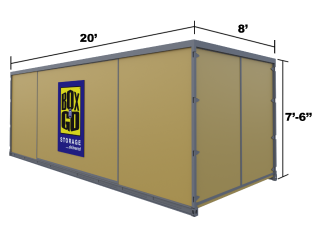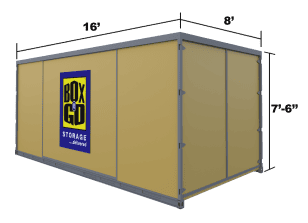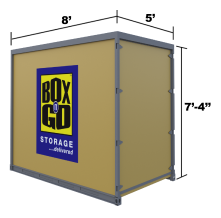


REVIEWS
RATING
GUARANTEE
Store on your driveway or inside our secure facility. Load/unload only once. Ground level access.


20’ Container – all weather.
Perfect for 3-bedroom residence.
5-7 rooms, furniture, appliances, etc.

16’ Container – all weather.
Perfect for 2-bedroom residence.
3-5 rooms, furniture, appliances, etc.

8’ Container – all weather.
Modular – works for any need.
Each fits 1-1.5 rooms.



- No truck to rent. We deliver storage to you!
- Load/Unload only once.
- Pay only for space you use.
- Secure, climate-friendly facility.
- Drive-up access
- Save money and time.
- Reduce the risk of accidents and injuries.
- No need to pay for gas, insurance & mileage!
- You only need to load your belongings once!
- No need to load and unload it all again into a storage unit.
- All containers come with easy ground level access!
(if storing at our facility)
- No not need to guess on how much space you actually need.
- Order an extra 8’ x 5’ unit. Do not use it – do not pay for it.
- Highest degree of security and protection.
- Our 8’ x 5’ units are breatheable – no mold or mildew.
- No funky smell when your belongings return.
(if storing at our facility)
- Access your units at ground level.
- No elevators, ramps, stairs to climb.
- Schedule access appointment & drive straight to your units.

How to Pack Your Living Room
Mirrors and Pictures: It’s best if you can crate them, or at least wrap mirrors and pictures in paper, bubble wrap and heavy cardboard, then bind with tape and pack in a mirror packing box. Most pictures and mirrors can be wrapped and packed in telescoping mirror cartons. Wrap each wall hanging individually with bubble wrap, blankets, or towels. Pack flat items on their edges. DO NOT lay mirror boxes flat! If possible, place between a mattress and box spring, or place on the side of your container. Fragile or valuable fine art may require special professional crating. We advise against packing such items for storage or moving inside the containers.
Stereo Equipment: If possible use your original boxes to store these items. When using other than original boxes make sure to tightly secure all contents. We recommend that DVD players be put into a storage box (either a medium, 3.0 cubic ft, or a large, 4.5 cubic ft box). If you have more than one of these items make sure that some form of cushion is used between them. Advance preparation is required for compact disc players, digital videodisc players and stereo turntables. On compact and digital videodisc players, secure the laser with transport screws located on the bottom or back of the unit. Most turntables have a plastic lock, which should be used to hold the tone arm in place. For additional protection, you may tie a piece of string around the arm in case the lock does not hold. Also, secure the platter (where the records are placed) by tightening the appropriate screws. These are usually located on top of the turntable, but check you owner’s manual if in doubt.
TIP: If it’s not feasible to pack your remote controls in the same carton with their corresponding units, consider packing all remotes in a separate box, clearly labeled.
Speakers: Pack speakers in well-cushioned dish packs.
Television Sets: Call your local cable company to request your service discontinued. If you have a converter box, return the box and keep the receipt for future reference. We recommend that the power cord be taped up (on the back of the TV and perhaps a sheet of bubble wrap to protect the monitor). Try and use original boxes to pack the TV in. Also, please refer to “10 Tips for Packing Your Electronics” for more packing ideas. Some large and plasma television sets may need to be crated by a professional.
Satellite Dish: Contact an electrician or technician from a satellite dish distributorship for the disconnection and disassembly of this sensitive equipment. Depending upon the construction and size of the unit, it may need to be professionally crated.
CDs, DVDs, Tapes and Records: Stand compact discs and records on edge, never flat, on a layer of crushed paper. Support at both ends with large, hardcover books or several pieces of cardboard cut to fit. Top with another layer of crushed paper. Identify contents on the outside of the box and mark, “FRAGILE”. Cassette tapes should be placed in their cases and wrapped individually in crumpled paper. Place individual tapes either vertically or horizontally on a couple of layers of crushed paper. If records are not in jackets, wrap individually in tissue paper or plastic wrap to protect from scratches. Records are heavy and therefore should be packed in small cartons.
Books and Documents: Pack books of the same general size together, in small book cartons for easy lifting. Pack them either flat, or with the spine touching the bottom of the carton. Do not pack with spine facing upward, as glue can break away from the binder. Do not place boxes directly on concrete floors, but use pallets or skids to prevent moisture absorption. Use packing to fill out empty pockets in the boxes. Do not pack fragile items in the same box with books and do not overload. These boxes will get heavy quickly so remember to use your legs when lifting. Do not pack boxes heavier than 50 pounds. Expensively bound volumes or those of sentimental value should be individually wrapped before packing. We advise against packing such items for storage or moving inside the containers.
Photographs: Family photographs, videos, slides and negatives should be packed in separate cartons rather than being combined with other household items. Protect framed photos with padding and cushioning, standing them on edge in a carton. Label cartons for easy identification. We advise against packing such items for storage or moving inside the containers.
Silk or Artificial Flowers: An arrangement of artificial flowers should be packed in a separate carton. Wrap carefully in plastic wrap, tissue paper or paper towels. If possible, fasten the base of the floral piece to the bottom of the carton to prevent shifting. Label the carton “FRAGILE – THIS SIDE UP”.
Lamps: Remove all bulbs and shades from lamps. Place small bases in dresser drawers with paper or cloth padding, and large ones in boxes with wadded-up paper in the extra space. Shades should be placed in individual boxes with wadded-up paper in the empty spaces. Often you can “nest” several lampshades together. Use a special box for all of these shades, rather than packing them with other items. Pack delicate lampshades separately. Do not use newsprint to wrap lampshades or any other goods that may be damaged by ink stains. Do not store heavy items on cartons containing lamps or lampshades. Pack in sturdy cartons labeled “fragile”. Label cartons “LAMP SHADES – FRAGILE – TOP LOAD ONLY.”
Chandeliers and Leaded Glass Shades: It is best to professionally crate large leaded or other glass lampshades or chandeliers.
Glass Table Tops, Marble Slabs, Large Mirrors, Paintings, Statues & Large Vases: It’s best to consider custom-made cartons and crates for items of this kind. Paper should never be permitted to touch the surface of an oil painting.
Rugs: Vacuum rugs, sprinkle with moth flakes, roll up and tie with rope. Rugs can be wrapped with paper pads for additional protection. Area rugs should be loaded last and unloaded first.
TV Stand/ Stereo Cabinet: Remove glass doors if possible and pack in a mirror carton.
Furniture: Shrink-wrap large, upholstered items Place a cardboard mat or plastic sheet on the floor and stand sofas on end. You may want to consider packing couch pillows in large boxes. Most lightweight chairs should be stacked seat-to-seat or placed upside down on tables. Table corners can be protected with cardboard. Make sure that all drawers and shelves are completely closed and taped shut. Try to cover furniture to protect from minor scratches. Particleboard furniture is not very sturdy, and cannot handle the weight at times. Invert light chairs so they are “seat-to-seat.” There usually is space between the legs for small, lightweight items. Finally, place a light dust cover over your furniture.
Piano: A professional piano service provider should take care of the preparations for packing and storing a grand or baby grand piano. Upright (spinet, console, studio) pianos usually do not require preparation in advance. All pianos should be pad-wrapped to protect the surface. Plan to have your piano tuned after storage.
Pool Table: Disassembly and crating of your pool table should be provided by a third-party service. If possible, contact the store where the pool table was purchased to obtain assistance. You will need to make arrangements to have the pool table uncrated, reassembled and leveled.

